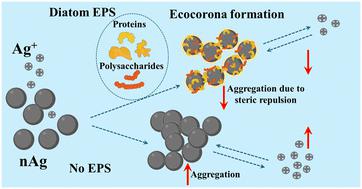当前位置:
X-MOL 学术
›
Environ. Sci.: Nano
›
论文详情
Our official English website, www.x-mol.net, welcomes your feedback! (Note: you will need to create a separate account there.)
Diatom-derived extracellular polymeric substances form eco-corona and enhance stability of silver nanoparticles
Environmental Science: Nano ( IF 5.8 ) Pub Date : 2024-06-25 , DOI: 10.1039/d4en00232f Rocco Gasco 1 , Isabelle A. M. Worms 1 , Arin Kantarciyan 1 , Vera I. Slaveykova 1
Environmental Science: Nano ( IF 5.8 ) Pub Date : 2024-06-25 , DOI: 10.1039/d4en00232f Rocco Gasco 1 , Isabelle A. M. Worms 1 , Arin Kantarciyan 1 , Vera I. Slaveykova 1
Affiliation

|
Silver nanoparticles (nAg) are extensively used across various fields and are frequently introduced into aquatic environments, where their behavior depends on environmental conditions. Extracellular polymeric substances (EPS) derived from aquatic organisms, such as diatoms, could play an important yet to be explored role in shaping the fate of nAg in aquatic environments. This study investigates the interactions between EPS, particularly those from the diatom Cyclotella meneghiniana, and citrate-coated nAg. The main objective is to understand how EPS influence the behaviours of nAg in freshwater settings, in terms of modulation of the nAg surface properties, colloidal stability and dissolution. To achieve these objectives a combination of the state-of-the-art spectroscopic and imaging techniques was employed. nAg was incubated with EPS isolated from an axenic C. meneghiniana culture, and their interactions were explored in a simulated freshwater environment over both short-term (0–2 h) and long-term (0–72 h) periods. The study focused on the changes in nAg, examining surface modulation, colloidal stability, dissolution, EPS adsorption on nAg, and the resulting eco-corona formation. The results indicate that EPS enhance the colloidal stability of nAg and decrease their dissolution in synthetic freshwater by adsorbing onto their surface and inducing steric repulsion between nAg particles. Visualization of the eco-corona formed by diatom EPS on nAg and its impact on aggregation processes is achieved through transmission electron microscopy. The formation of the EPS corona is attributed to the presence of diverse biopolymers within EPS, particularly proteins and polysaccharides. Fluorescence quenching studies on protein fluorophores demonstrate the formation, through hydrophobic interactions, of protein–nAg complex, further confirmed by AF4-DAD-FLD-ICP-MS. In a broader context, the results of this mechanistic study imply that diatoms, through the release of EPS, may significantly influence the destiny and possibly the bioavailability of nAg in EPS-abundant aquatic environments.
中文翻译:

硅藻衍生的胞外聚合物形成生态电晕并增强银纳米颗粒的稳定性
银纳米粒子(nAg)广泛应用于各个领域,并经常被引入水生环境中,其行为取决于环境条件。源自水生生物(例如硅藻)的胞外聚合物(EPS)可能在塑造纳米银在水生环境中的命运方面发挥重要的尚未探索的作用。本研究调查了 EPS(特别是来自硅藻 Cyclotella meneghiniana 的 EPS)与柠檬酸盐涂层 nAg 之间的相互作用。主要目标是了解 EPS 如何影响 nAg 在淡水环境中的行为,包括调节 nAg 表面特性、胶体稳定性和溶解。为了实现这些目标,采用了最先进的光谱和成像技术的结合。 nAg 与从无菌 C. meneghiniana 培养物中分离出的 EPS 一起孵育,并在模拟淡水环境中在短期(0-2 小时)和长期(0-72 小时)期间探索它们的相互作用。研究重点是 nAg 的变化,检查表面调节、胶体稳定性、溶解、nAg 上的 EPS 吸附以及由此产生的生态电晕形成。结果表明,EPS 通过吸附在纳米银表面并诱导纳米银颗粒之间的空间排斥,增强了纳米银的胶体稳定性,并减少了纳米银在合成淡水中的溶解。通过透射电子显微镜实现了硅藻 EPS 在 nAg 上形成的生态电晕及其对聚集过程的影响的可视化。 EPS 冠层的形成归因于 EPS 中存在多种生物聚合物,特别是蛋白质和多糖。 对蛋白质荧光团的荧光猝灭研究表明,通过疏水相互作用形成了蛋白质-nAg 复合物,AF4-DAD-FLD-ICP-MS 进一步证实了这一点。在更广泛的背景下,这项机制研究的结果表明,硅藻通过释放 EPS,可能会显着影响 nAg 在 EPS 丰富的水生环境中的命运和生物利用度。
更新日期:2024-06-27
中文翻译:

硅藻衍生的胞外聚合物形成生态电晕并增强银纳米颗粒的稳定性
银纳米粒子(nAg)广泛应用于各个领域,并经常被引入水生环境中,其行为取决于环境条件。源自水生生物(例如硅藻)的胞外聚合物(EPS)可能在塑造纳米银在水生环境中的命运方面发挥重要的尚未探索的作用。本研究调查了 EPS(特别是来自硅藻 Cyclotella meneghiniana 的 EPS)与柠檬酸盐涂层 nAg 之间的相互作用。主要目标是了解 EPS 如何影响 nAg 在淡水环境中的行为,包括调节 nAg 表面特性、胶体稳定性和溶解。为了实现这些目标,采用了最先进的光谱和成像技术的结合。 nAg 与从无菌 C. meneghiniana 培养物中分离出的 EPS 一起孵育,并在模拟淡水环境中在短期(0-2 小时)和长期(0-72 小时)期间探索它们的相互作用。研究重点是 nAg 的变化,检查表面调节、胶体稳定性、溶解、nAg 上的 EPS 吸附以及由此产生的生态电晕形成。结果表明,EPS 通过吸附在纳米银表面并诱导纳米银颗粒之间的空间排斥,增强了纳米银的胶体稳定性,并减少了纳米银在合成淡水中的溶解。通过透射电子显微镜实现了硅藻 EPS 在 nAg 上形成的生态电晕及其对聚集过程的影响的可视化。 EPS 冠层的形成归因于 EPS 中存在多种生物聚合物,特别是蛋白质和多糖。 对蛋白质荧光团的荧光猝灭研究表明,通过疏水相互作用形成了蛋白质-nAg 复合物,AF4-DAD-FLD-ICP-MS 进一步证实了这一点。在更广泛的背景下,这项机制研究的结果表明,硅藻通过释放 EPS,可能会显着影响 nAg 在 EPS 丰富的水生环境中的命运和生物利用度。
















































 京公网安备 11010802027423号
京公网安备 11010802027423号